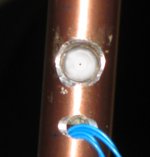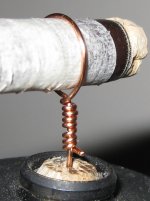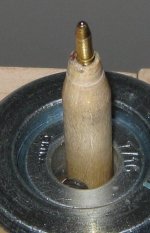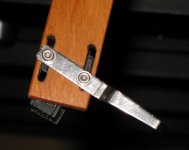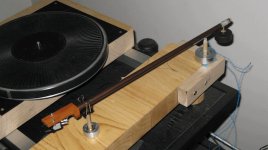I tried using a digital camera to get some close-ups. Guess I should read a book or something about getting good ones (every time I try using a "macro" setting, the pix are always out of focus...)
I had the same problem. Recently discovered that if i switch the setting from auto to M it would focus (Canon)
dave
finally some pix.
this arm is intended as the utmost in simplicity, not requiring a machine shop to produce.
I've attached a couple of pix showing a ball-point pen "nib", as installed in a sharpened (and then blunted) dowel, and the female bearing (as described earlier). I used some steel collars available cheaply anywhere to hold the male bearing support, and to attach an existing arm rest to, so I can have that. I also installed a little finger lift, as a concession to those that might want one.
wjlamp:Yes! By rotating the weight about the axis of the tonearm tube, azimuth is adjusted (I did say it was dumb-simple ).
).
The ball point "bearings" I sent out to Dave's are better than the one pictured. The tape can be trimmed as well to make it look more presentable, as well as stuffing a small cork into the end (as pictured in Dave's post showing a few arm tubes).
this arm is intended as the utmost in simplicity, not requiring a machine shop to produce.
I've attached a couple of pix showing a ball-point pen "nib", as installed in a sharpened (and then blunted) dowel, and the female bearing (as described earlier). I used some steel collars available cheaply anywhere to hold the male bearing support, and to attach an existing arm rest to, so I can have that. I also installed a little finger lift, as a concession to those that might want one.
wjlamp:Yes! By rotating the weight about the axis of the tonearm tube, azimuth is adjusted (I did say it was dumb-simple
The ball point "bearings" I sent out to Dave's are better than the one pictured. The tape can be trimmed as well to make it look more presentable, as well as stuffing a small cork into the end (as pictured in Dave's post showing a few arm tubes).
Attachments
this arm is intended as the utmost in simplicity, not requiring a machine shop to produce.
<snip>
Exactly which is why I was so interested.. I have a basement machine shop but am frankly a bit of a menace around those machines - I'm taking it slow. The "Nanook 129" is exactly what the doctor ordered. This will be my starting point for learning what works.. It's way cool..
a few more pix (unsure if I can post more than 3 at a time)
Kevin, I did say it is dumb-simple and it is.
Should I continue to develop this as a commercial product, obviously the fit'n finish need to increase (but if I can, I'll leave the sound alone as much as possible). One area for improvement worth considering is damping the arm if there are any nasty resonances. I think due to the low mass of the complete system (25-ish grams less counter-weigh, but including cartridge), the stored energies are minimal. I was thinking of a couple ideas as posted in my "what you need to complete" list a few posts back.
This arm was inspired by Charles Altmann and his "joke" arm, just using better materials than he chose. Depending on how far one might like to take it, $$$ ad nauseam could be spent on tonearm wire (internal) , clips, and some fossilized Yak excrement to fashion the headshell out of. But that goes completely against the intent of the arm. All I wanted were good quality, readily available parts, that could be used in a (hopefully) clever way. Think of it as a tonearm equivalent to Nelson Pass' "kitchen table" amplifiers
Kevin, I did say it is dumb-simple and it is.
Should I continue to develop this as a commercial product, obviously the fit'n finish need to increase (but if I can, I'll leave the sound alone as much as possible). One area for improvement worth considering is damping the arm if there are any nasty resonances. I think due to the low mass of the complete system (25-ish grams less counter-weigh, but including cartridge), the stored energies are minimal. I was thinking of a couple ideas as posted in my "what you need to complete" list a few posts back.
This arm was inspired by Charles Altmann and his "joke" arm, just using better materials than he chose. Depending on how far one might like to take it, $$$ ad nauseam could be spent on tonearm wire (internal) , clips, and some fossilized Yak excrement to fashion the headshell out of. But that goes completely against the intent of the arm. All I wanted were good quality, readily available parts, that could be used in a (hopefully) clever way. Think of it as a tonearm equivalent to Nelson Pass' "kitchen table" amplifiers
Attachments
Last edited:
Think of it as a tonearm equivalent to Nelson Pass' "kitchen table" amplifiers
Hmmmmmm ......... I can see the headlines now....... Burning Amp lit up by flaming arrow tonearm.
As an archer...I just love the 'misappropriation' of bareshafts! MUST give this one a go when we find a bigger place. I love it, congrats!
May I offer a suggestion? I know when I build mine, I'll keep with the theme and use a hunting broadhead for the pivot....
L
May I offer a suggestion? I know when I build mine, I'll keep with the theme and use a hunting broadhead for the pivot....
An externally hosted image should be here but it was not working when we last tested it.
L
Last edited:
Tone-arm Wire?
Hi
Great arm, am very inspired by this and the oak unipivot elsewhere to have a go.
Can you tell me what wire you used for the arm.
Is it the stuff used for wire wrapping ?
I don't have much fine wire to hand, so would need to get some in.
Any recommendations ?
Cheers Simon..

tonearm wire
Hi
Great arm, am very inspired by this and the oak unipivot elsewhere to have a go.
Can you tell me what wire you used for the arm.
Is it the stuff used for wire wrapping ?
I don't have much fine wire to hand, so would need to get some in.
Any recommendations ?
Cheers Simon..

er, Dave, if ya had a money clip like that, we'd be better friends...
I rarely have cash so it just holds the magic plastic.
dave
As an archer...I just love the 'misappropriation' of bareshafts! MUST give this one a go when we find a bigger place. I love it, congrats!
May I offer a suggestion? I know when I build mine, I'll keep with the theme and use a hunting broadhead for the pivot....
An externally hosted image should be here but it was not working when we last tested it.
L
I could have used points, but the idea of a proper bearing appealed to me, whether it actual rotates or not. The use of the arrow shafts is based on two things, strength and light weight. It also seems to me to be the least expensive way of getting good tubing...
Naim was the originator of using arrow shafts as tonearms in their "Aro" tonearm, as far as I know. As I've previously stated, the intent was to create an "Altmann" style arm using better materials (but not stupidly expensive ones)...
The internal (and in my case external wire as well-- as I am believer in a single run of wire from cartridge to phono stage) is Kynar, otherwise known as "wire wrap" wire. I had this on hand, but P10 suggested its use. Previously I had used recycled wire from dead computer mice and cheap and terrible headphones (the only thing that actually is quite good in a cheap set of headphones). The Kynar was soldered to some used cartridge tags, but I've used mini-sub D connectors from RadioShack (or "the Source" in canuckland). The RCA plugs were from Princess Auto (think of it like a Canadian "Harbor Freight Tools" store or "Tractor Supply"), if I recall correctly.
If a "high-end" version arm were to be built and sold as a commercial product, the laws of manufacturing costs VS. selling price would need to be in the 7-10 X's range to make it work, which is pretty typical for mass production.
Hi
Great arm, am very inspired by this and the oak unipivot elsewhere to have a go.
Can you tell me what wire you used for the arm.
Is it the stuff used for wire wrapping ?
I don't have much fine wire to hand, so would need to get some in.
Any recommendations ?
Cheers Simon..
Try this one.It is near you btw
Home - Trans-Fi Audio
go to his ebay shop tag
B.L.
Still using Easton arrow shafts
Quite clever using an arrow shaft, as they're lightweight, very strong, built to very tight tolerances and readily available.
Three years ago, when I first toyed with the ideas of a DIY unipivot tonearm, I acquired a 'blemished/damaged' arrow from the local sporting goods shop. It was a freebie. It appears to be carbon fiber. I never used it, opting instead to build the oak unipivot as detailed in my recent thread.
Now my thinking is swinging back towards the arrow gathing dust out in my shop.
A couple of questions:
Are you using an aluminum shaft? (Looks like it from one of those detail photos.)
I'm aware that there are three common shaft types available:
Aluminum alloy 7075-T9
Carbon fiber
Composite carbon fiber/aluminum
Curious if you've done any experimentation with the three types and have concluded that one material is better than the other?
calling all builders of the "219" tonearm and arrow shafts...
I'm using aluminium, Easton shafts (7075 I think). I don't like the idea of carbon fibre anything, regardless of the high performance characteristics. I'd prefer using wood if I could devise a way to make them consistent. Bamboo comes to mind...
The benefit of using arrow shafts is that they are built to a high standard, with very good materials at a very low price (for what they are). No serious machining is required, although I see the need for much better fit and finish if I were to offer them for sale (at a ridiculously low price of course). The goal is to make something of high quality using as many pre-built parts as possible, so that the least amount of time is required.
As I am educated in manufacturing process technology, the idea was to design for manufacturing, right from the very beginning. No use designing an arm that uses several hundreds (or thousands of ) dollars worth of parts and sell them for a very minor profit (basically paying someone's wages). Kits can be made, custom lengths, etc, very easily. These could be sold for a reasonable profit and at a relatively low price compared to everything else out there. Tonearm prices kinda pi** me off, other than the Rega arms which are an incredible value. I'm really talking about the hinderance the cost of a decent arm can be to so many either getting back into vinyl or starting out in it. Obviously getting a (at minimum) competent tonearm is one thing, and addressing the cost is another.
The original "Nanook's $2.19 tonearm" was just a very quick try, using as many free or used bits I could find and re-purpose. Based on my original listening evaluations (and others' too), it has justified further development. Many have commented on the simplicity of the design, But basically solid principles had been used in upgrading the "Altmann arm".
The "219" as I now call it (in reference to the original amount of money I spent on the original) is not intended in anyway to compete against the very well engineered arms by SME, Schroeder, Clearaudio, Kuzma, Origin Live, Rega and all the rest (too many to list). It is what I think as a minimum, should be used as an arm. The fact (in my opinion) that it competes with my SME 309, is more a testament to the absolute simplicity and quality of components chosen. The design basically falls on the feet of Charles Altmann, whose arm has inspired me to try.
There are much more complex arms to try to build, and certainly a DIY version of a Schroder, if implemented well is a stand-out. But please folks, have no illusions. This arm, as it stands is proof of concept, and easy to build. It also sounds (to my ears) very good, but it is not a $10,000 tonearm. Perhaps if any out there build one, and compare it to a $10,000 tonearm, then I can have some sort of comparison.
If any attempt the arm using any type of arrow shafts, PLEASE USE EYE PROTECTION WHILE ATTEMPTING TO DRILL ANY SHAFTS!
Thanks must be given to Dave Dlugos and to Bernie (last name unknown) . Dave put me in touch with Bernie who had showed some interest in building an arm, and who was generous enough with his time to send a couple of prototype headshells (similar to the Yamamoto headshells, but patterned after an old Kenchraft headshell) and provide the ones in the "kits" that were available at the 2010 Van Isle DIY audio 'fest held at Dave's.
I'm using aluminium, Easton shafts (7075 I think). I don't like the idea of carbon fibre anything, regardless of the high performance characteristics. I'd prefer using wood if I could devise a way to make them consistent. Bamboo comes to mind...
The benefit of using arrow shafts is that they are built to a high standard, with very good materials at a very low price (for what they are). No serious machining is required, although I see the need for much better fit and finish if I were to offer them for sale (at a ridiculously low price of course). The goal is to make something of high quality using as many pre-built parts as possible, so that the least amount of time is required.
As I am educated in manufacturing process technology, the idea was to design for manufacturing, right from the very beginning. No use designing an arm that uses several hundreds (or thousands of ) dollars worth of parts and sell them for a very minor profit (basically paying someone's wages). Kits can be made, custom lengths, etc, very easily. These could be sold for a reasonable profit and at a relatively low price compared to everything else out there. Tonearm prices kinda pi** me off, other than the Rega arms which are an incredible value. I'm really talking about the hinderance the cost of a decent arm can be to so many either getting back into vinyl or starting out in it. Obviously getting a (at minimum) competent tonearm is one thing, and addressing the cost is another.
The original "Nanook's $2.19 tonearm" was just a very quick try, using as many free or used bits I could find and re-purpose. Based on my original listening evaluations (and others' too), it has justified further development. Many have commented on the simplicity of the design, But basically solid principles had been used in upgrading the "Altmann arm".
The "219" as I now call it (in reference to the original amount of money I spent on the original) is not intended in anyway to compete against the very well engineered arms by SME, Schroeder, Clearaudio, Kuzma, Origin Live, Rega and all the rest (too many to list). It is what I think as a minimum, should be used as an arm. The fact (in my opinion) that it competes with my SME 309, is more a testament to the absolute simplicity and quality of components chosen. The design basically falls on the feet of Charles Altmann, whose arm has inspired me to try.
There are much more complex arms to try to build, and certainly a DIY version of a Schroder, if implemented well is a stand-out. But please folks, have no illusions. This arm, as it stands is proof of concept, and easy to build. It also sounds (to my ears) very good, but it is not a $10,000 tonearm. Perhaps if any out there build one, and compare it to a $10,000 tonearm, then I can have some sort of comparison.
If any attempt the arm using any type of arrow shafts, PLEASE USE EYE PROTECTION WHILE ATTEMPTING TO DRILL ANY SHAFTS!
Thanks must be given to Dave Dlugos and to Bernie (last name unknown) . Dave put me in touch with Bernie who had showed some interest in building an arm, and who was generous enough with his time to send a couple of prototype headshells (similar to the Yamamoto headshells, but patterned after an old Kenchraft headshell) and provide the ones in the "kits" that were available at the 2010 Van Isle DIY audio 'fest held at Dave's.
Last edited:
I'm using aluminium, Easton shafts (7075 I think). I don't like the idea of carbon fibre anything, regardless of the high performance characteristics. I'd prefer using wood if I could devise a way to make them consistent. Bamboo comes to mind...
Admittedly, I don't know much about carbon fibre other than it's lightweight and strong. Is there something about it that makes it unsuitable for tonearm shafts?
cactusboy...carbon fibre...
well the dust given off cutting it is hazardous to your health...
I like organic materials (wood and paper), and metals. At least toxins are not given off (unless some hardwoods or formaldehyde from MDF manufacturing).
I don't think there is anything wrong per se, but I don't like carbon fibre bicycles, and don't see the need for it in tonearms. In fact if a carbon fibre arm ends up being too light, that introduces a s complete set of new problems...
well the dust given off cutting it is hazardous to your health...
I like organic materials (wood and paper), and metals. At least toxins are not given off (unless some hardwoods or formaldehyde from MDF manufacturing).
I don't think there is anything wrong per se, but I don't like carbon fibre bicycles, and don't see the need for it in tonearms. In fact if a carbon fibre arm ends up being too light, that introduces a s complete set of new problems...
well the dust given off cutting it is hazardous to your health...
I like organic materials (wood and paper), and metals. At least toxins are not given off (unless some hardwoods or formaldehyde from MDF manufacturing).
I don't think there is anything wrong per se, but I don't like carbon fibre bicycles, and don't see the need for it in tonearms. In fact if a carbon fibre arm ends up being too light, that introduces a s complete set of new problems...
Hi Stew,
There are a lot of toxic substances around and it sometimes depends on how they're handled. If you sand or grind Abalone Shell (Mother of Pearl) the dust is extremely toxic, although if cut with a knife by hand or use a hand scraper, it isn't too bad. Just the same, a lot of people that carve NW Indian art use artificial Mother of Pearl as a safer substitute.
Yew wood is another toxic substance, if misused. It's been the wood of choice for making longbows, for at least a couple of thousand years. However, the ancient Britons served wine in goblets turned from Yew wood to the Roman Legionnaires in a celebration of Rome's victory over them. In a couple hours, the Romans were all dead, as the interaction of the Yew with the wine evidently produces a deadly poison.
You're the expert, but I would think that an arm that's too light would be easier to fix, than one that's too heavy. I've never used carbon fiber for anything, so I have no opinion one way or the other on it's use.
Best Regards,
TerryO
I don't think there is anything wrong per se, but I don't like carbon fibre bicycles, and don't see the need for it in tonearms.
I love my Argon 18 Platinum HDS.

Just heading out for a spin.

jeff
- Status
- This old topic is closed. If you want to reopen this topic, contact a moderator using the "Report Post" button.
- Home
- Source & Line
- Analogue Source
- my latest iteration of "Nanook's 219 tonearm"..
